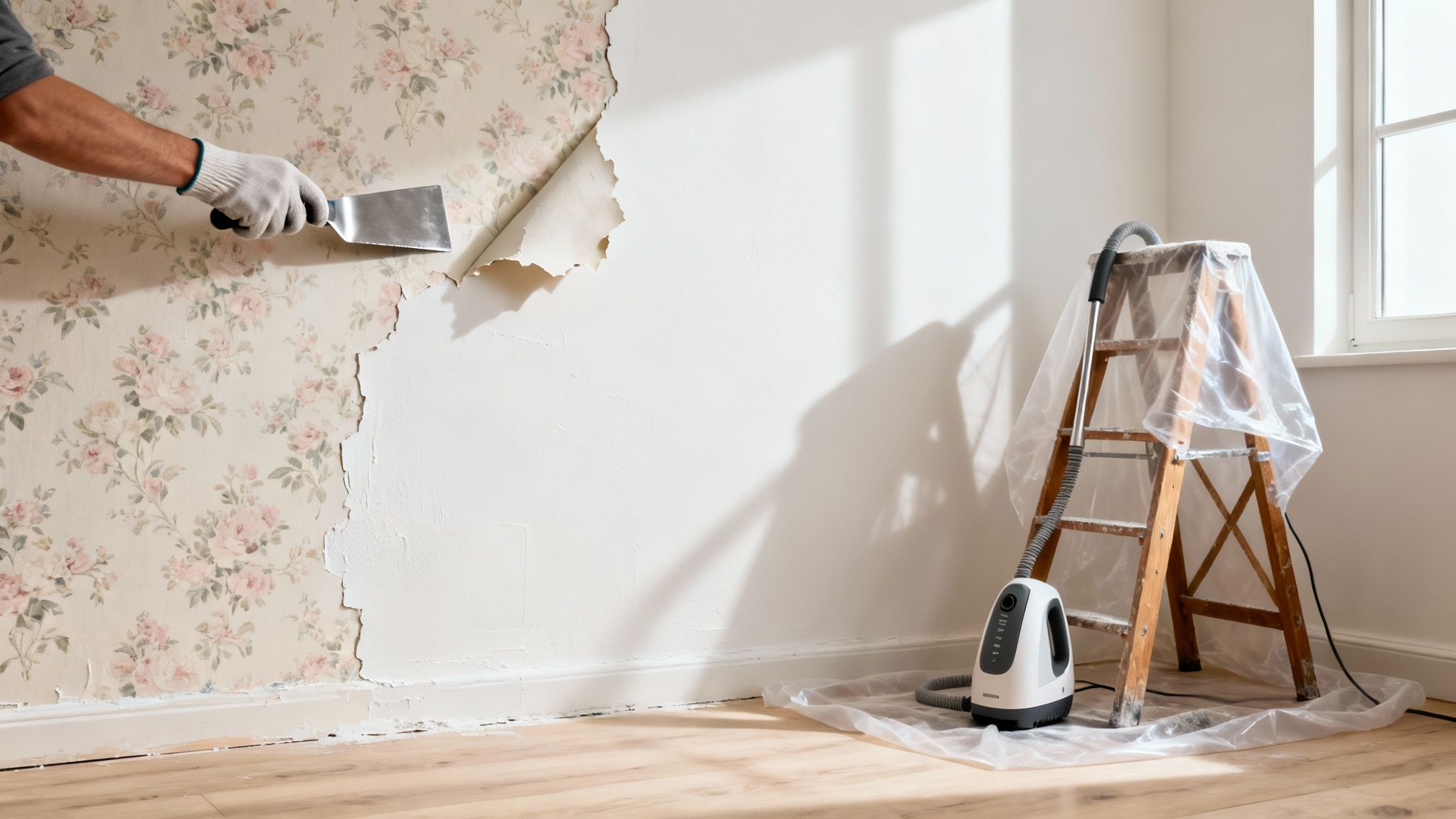The secret to a truly polished garden lies in its details, and few are more impactful than the humble flower bed edge. More than just a barrier to keep lawn and soil separate, the right edging is a frame for your botanical masterpiece. It defines shapes, creates clean lines, and adds a layer of texture and style that elevates the entire landscape. But with a vast array of materials and designs available, choosing the perfect one can feel overwhelming.
This guide simplifies the process, exploring ten distinct flower bed edging ideas, each with its own unique character, cost, and installation considerations. Whether you envision a rustic cottage feel with woven wattle or a sleek, modern boundary using Corten steel, you will find the necessary inspiration and practical advice here. We will provide the details needed to create beautiful, lasting borders that genuinely transform your outdoor space. Let's delve into the options that will give your garden the perfect finishing touch.
1. Natural Stone Edging
Natural stone edging offers a timeless, organic boundary that seamlessly integrates with garden landscapes. This method uses materials like flagstone, limestone, or fieldstone to define flower beds, providing a durable and rustic charm that other materials struggle to replicate. The inherent variations in shape, size, and colour mean no two stone borders are exactly alike, creating a truly bespoke finish for your garden.
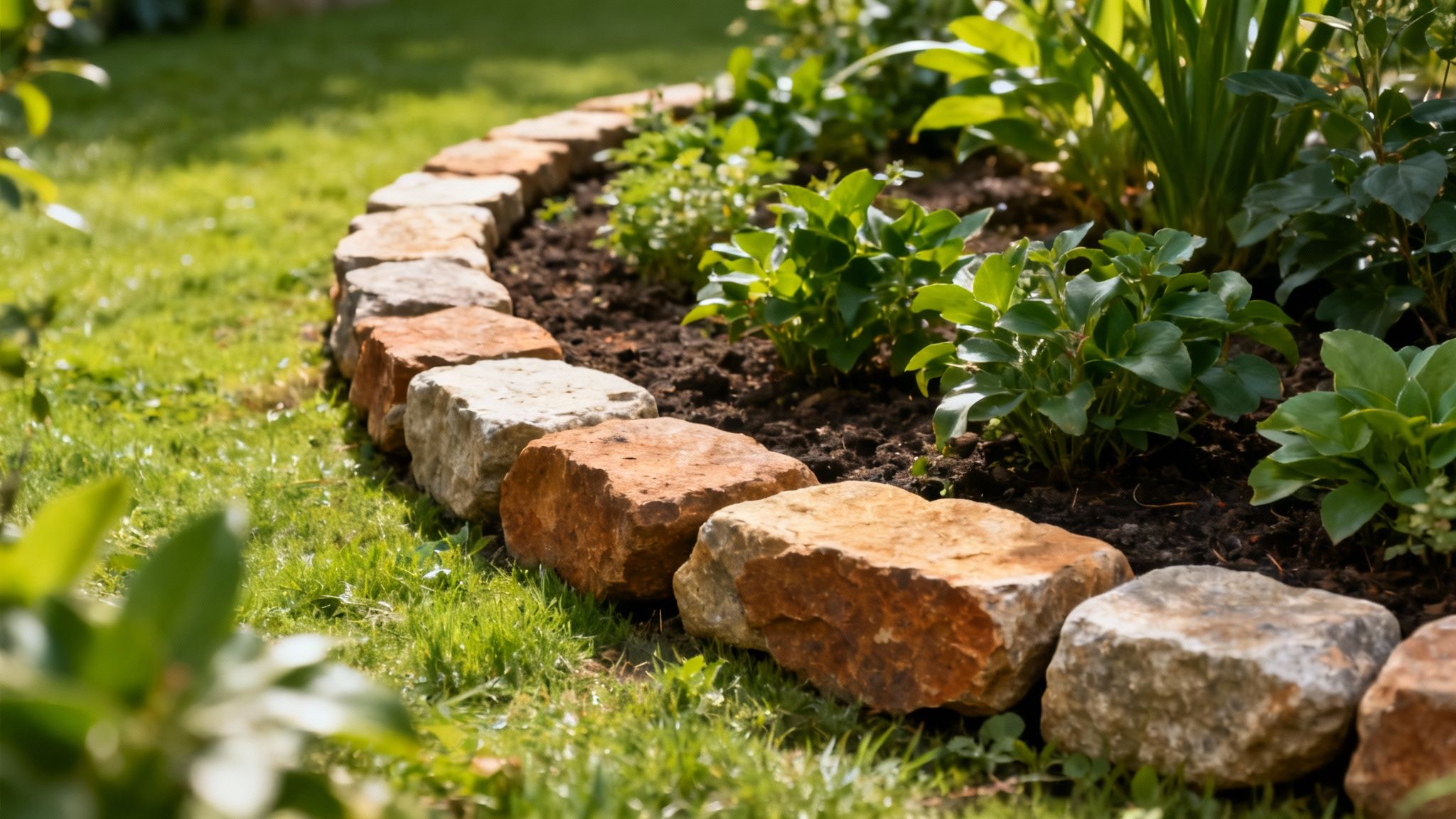
Why Choose Natural Stone?
This is one of the most versatile flower bed edging ideas, suited for styles ranging from quaint English cottage gardens using Cotswold stone to formal estates with precisely cut limestone. Its substantial weight ensures it stays in place, effectively containing soil and mulch while acting as a robust barrier against encroaching grass.
Practical Installation Tips
For a stable and long-lasting border, follow these key steps:
- Create a Foundation: Excavate a shallow trench (around 10-15 cm deep) and add a 5-7 cm layer of gravel or sand. This base improves drainage and prevents the stones from shifting over time.
- Secure Placement: Bury each stone at least one-third of its depth into the ground. This anchors it securely, ensuring it won't be easily dislodged.
- Weed Prevention: Lay landscape fabric in the trench and up the back of the stones before backfilling. This simple step will significantly reduce weed and grass growth through the gaps.
- Source Locally: Opting for local stone varieties can lower costs and ensures the material is well-suited to your region's climate.
2. Metal Edging (Steel and Aluminum)
Metal edging creates a sharp, clean, and almost invisible line, making it a favourite for modern and minimalist garden designs. Made from thin, flexible strips of steel or aluminium, it provides a precise boundary that contains mulch and soil without visually overpowering the plants. Steel options like Cor-Ten develop a desirable rustic patina over time, while powder-coated aluminium maintains a consistent colour for years.
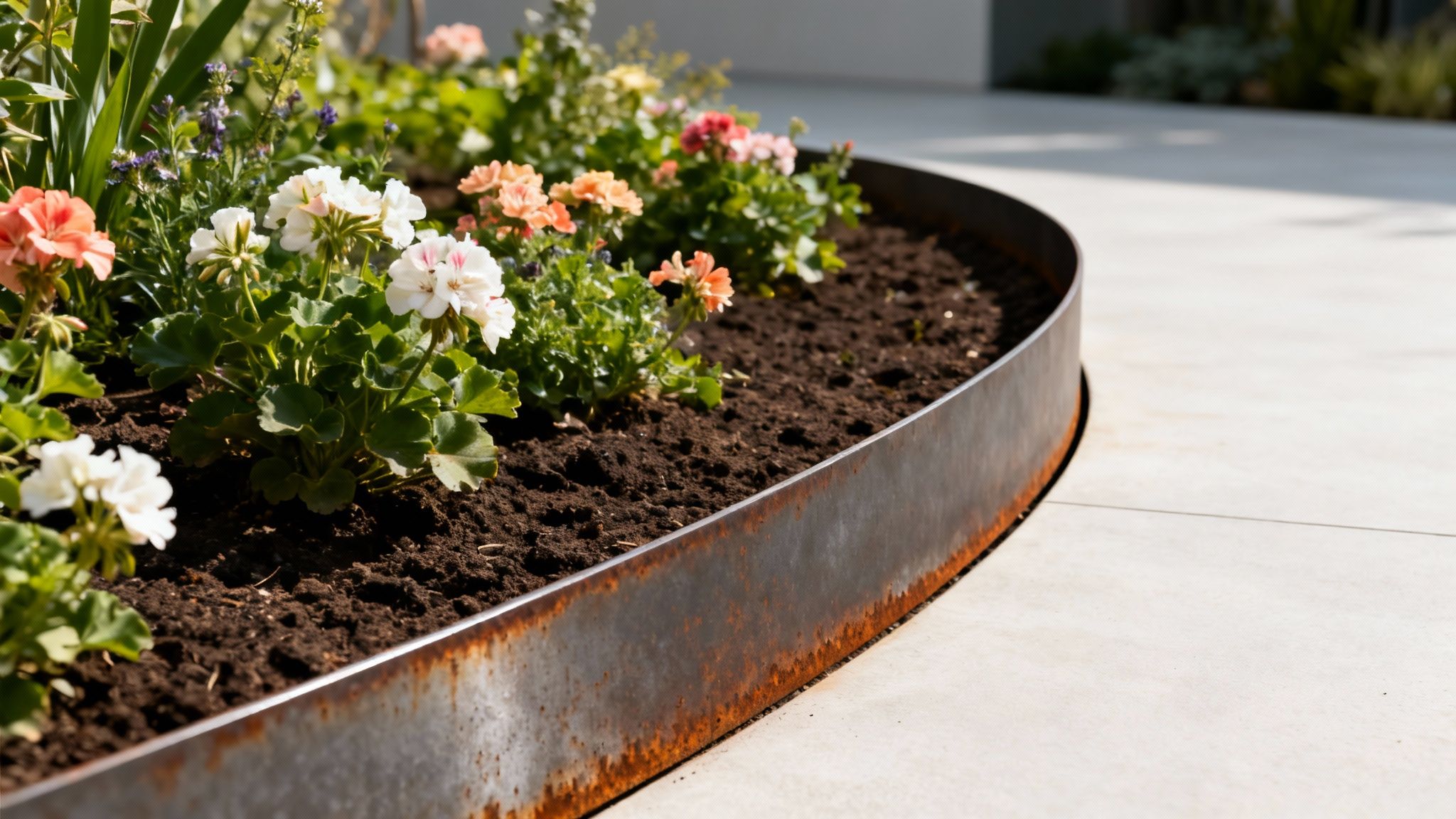
Why Choose Metal Edging?
This is one of the best flower bed edging ideas for creating seamless curves and crisp geometric shapes that are difficult to achieve with bulkier materials. Its slender profile is perfect for contemporary landscapes, commercial properties requiring a maintained look, and Zen gardens where clean lines are paramount. Its durability also ensures a long-lasting and low-maintenance solution.
Practical Installation Tips
For a professional-looking and secure finish, follow these guidelines:
- Prepare a Trench: Dig a narrow trench approximately 10-12 cm deep along the border of your flower bed to guide the placement of the edging.
- Tap Gently: Use a rubber mallet to carefully tap the edging into the trench. This prevents damaging the material or its finish. Aim to leave 2-5 cm exposed above ground level.
- Connect Sections: To create a continuous line, overlap the ends of each strip by 5-7 cm and secure them with the provided stakes or fasteners.
- Handle with Care: Always wear heavy-duty gloves during installation, as the edges of the metal strips can be extremely sharp.
3. Brick Edging
Brick edging provides a classic, orderly border that brings a sense of formal structure and warm colour to garden designs. This traditional method uses clay or concrete bricks laid in various patterns, from a simple flat course to an angled "sawtooth" arrangement. Its versatility allows it to complement a wide range of architectural styles, from the charming, reclaimed brick paths of a country cottage to the clean lines of a modern urban garden.
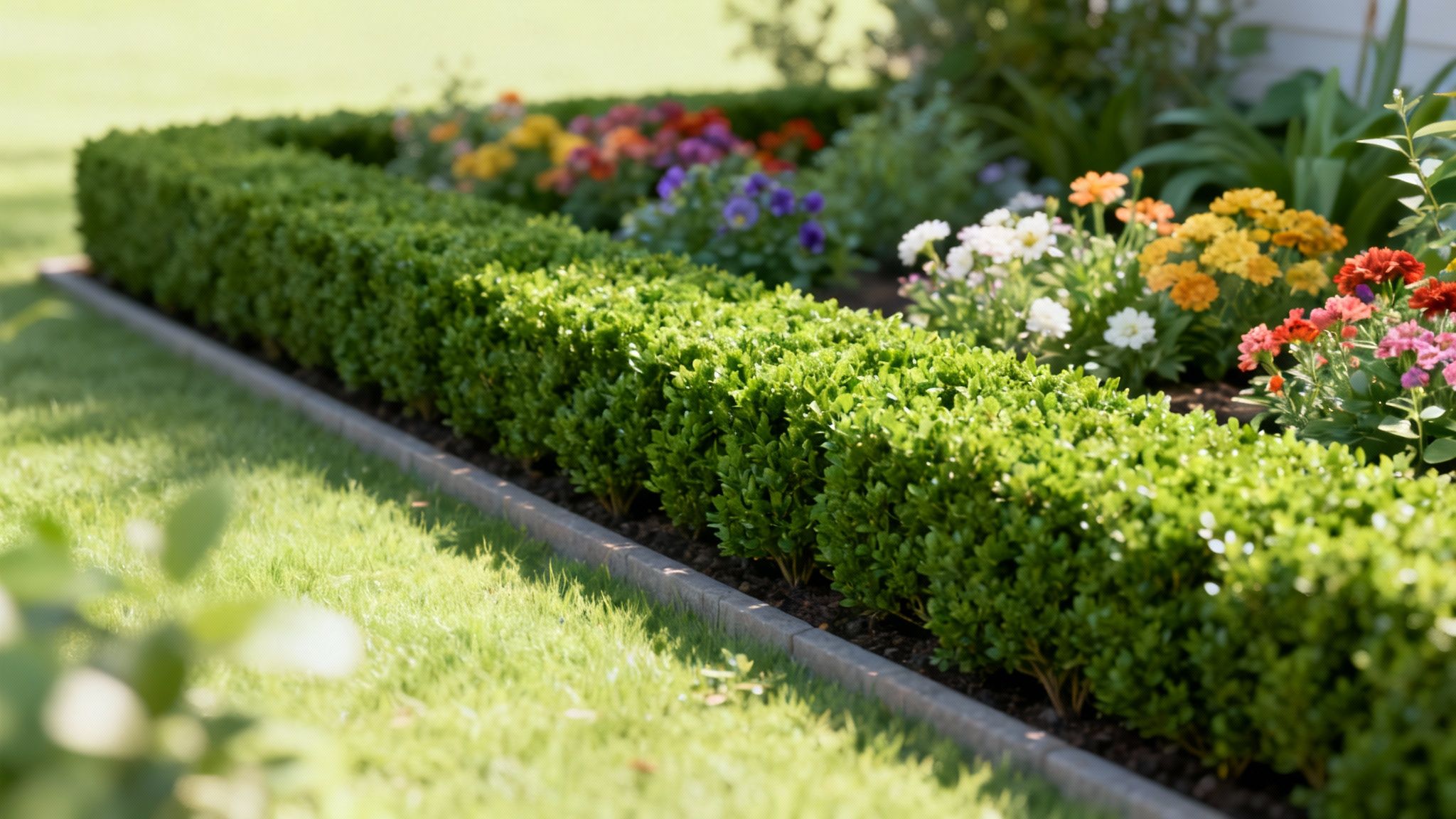
Why Choose Brick?
As one of the most enduring flower bed edging ideas, brick is prized for its durability, uniform shape, and timeless appeal. It creates a neat, pronounced edge that is perfect for containing soil and mulch while providing a convenient strip for mower wheels. Whether you're aiming for the historic feel of a Victorian kitchen garden or a simple, functional border, brick is a reliable and aesthetically pleasing choice.
Practical Installation Tips
A solid foundation is crucial for a brick border that won't heave or shift.
- Prepare the Trench: Dig a trench about 15-20 cm deep and wide enough for your brick pattern. A level base is key for a professional finish.
- Add a Sand Base: Add a 5-7 cm layer of sharp sand or paver base to the trench and compact it firmly. This provides a stable, level foundation and aids drainage.
- Set the Bricks: Place your bricks tightly together on the sand base, tapping each one with a rubber mallet to ensure it is level and secure.
- Lock in Place: For a longer-lasting installation, sweep polymeric sand into the joints. When lightly watered, it hardens to lock the bricks together and suppress weed growth.
- Consider Reclaimed Bricks: Sourcing reclaimed bricks can add unique character and a weathered patina to your garden beds while being an environmentally friendly option.
4. Plastic or Rubber Edging
Plastic and rubber edging offer a lightweight, flexible, and economical solution for defining garden beds. Often made from recycled materials, these products are available in rolls or interlocking sections that are easy to install. Modern versions have improved significantly in appearance and durability, with some designed to mimic natural materials like stone or wood while remaining UV-resistant and flexible enough to create sweeping curves.
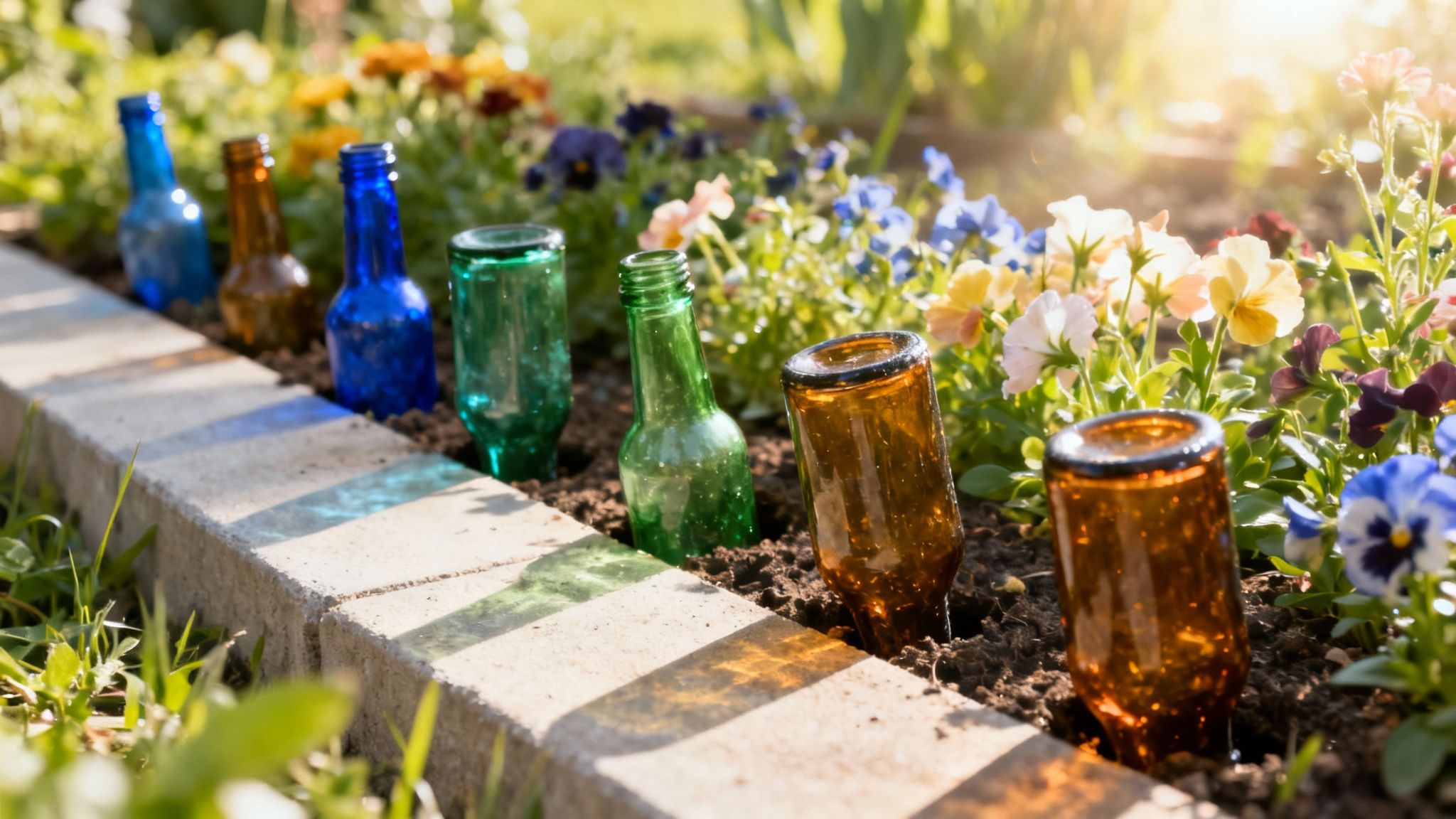
Why Choose Plastic or Rubber?
This is one of the most practical and accessible flower bed edging ideas for temporary layouts, rental properties, or budget-conscious projects. Its flexibility is perfect for creating non-linear designs, from gentle waves to tight circles around trees. For those seeking low-effort installation, it provides a clean line with minimal fuss, making it a great starting point for new gardeners. Its lightweight nature and simple setup align well with a low-maintenance approach to gardening. Explore more low-maintenance garden ideas to complement this easy edging choice.
Practical Installation Tips
For a neat and secure border that lasts, focus on a solid installation:
- Create a Trench: Dig a clean trench about 10 cm deep along your desired border line. This helps to seat the edging firmly and keep it upright.
- Secure with Stakes: For rolled edging, ensure it is staked every 1-1.2 metres and at the beginning and end of each curve to prevent it from warping or lifting.
- Choose Wisely: Opt for thicker, commercial-grade products for better durability and longevity. Thinner options may become brittle and crack more quickly, especially in colder climates.
- Install When Warm: If possible, install plastic or rubber edging on a warm day. The material will be more pliable and easier to unroll and shape into curves.
5. Wood and Timber Edging
Wood and timber edging introduces a warm, organic character to garden borders, ranging from rustic logs to refined cedar boards. This versatile material offers numerous styles, including horizontal planks, vertical log palisades, and robust landscape timbers, each providing a distinct natural texture. Wood can be stained, painted, or left to weather naturally, allowing it to complement various garden aesthetics.
Why Choose Wood and Timber?
This is one of the most adaptable flower bed edging ideas, perfect for creating the charming borders of a cottage garden with weathered cedar half-logs or building structured raised beds in a modern allotment. Its natural appearance helps it blend seamlessly into the landscape, providing an effective barrier for mulch and soil while adding a touch of classic design.
Practical Installation Tips
To ensure your wooden border is both attractive and long-lasting, consider these key steps:
- Choose Wisely: Select naturally rot-resistant woods like cedar, redwood, or black locust for maximum longevity. Avoid using older, pressure-treated wood in vegetable patches due to potential chemical leaching.
- Ensure Stability: Dig a shallow trench and bury the bottom 5-7 cm of the wood below soil level. This anchors the edging securely and prevents it from shifting or being pushed out of place.
- Prevent Rust: Use galvanised or stainless steel screws and nails when fastening pieces together. This will stop rust from forming and staining the wood over time.
- Maintain and Protect: Apply a quality wood preservative or sealant every two to three years to protect against moisture and decay. If you're looking to add colour, you can find a helpful guide on how to paint wood for a durable finish.
6. Concrete or Paver Edging
Concrete and paver edging offer a highly versatile and durable solution for defining garden beds. This category includes everything from professionally poured continuous curbing to individual interlocking pavers and decorative blocks. The result is a clean, crisp border that can be tailored to suit any garden style, from modern minimalist designs with smooth grey concrete to Mediterranean themes using terracotta-coloured pavers.
Why Choose Concrete or Pavers?
This option is one of the most customisable flower bed edging ideas available. Poured concrete can follow any curve you desire, while pavers come in a vast array of shapes, sizes, and colours. Its strength provides a formidable barrier against lawn creep and effectively contains soil and mulch, making it ideal for both residential gardens and high-traffic commercial landscapes.
Practical Installation Tips
For a professional-looking and long-lasting finish, consider these key steps:
- Lay a Solid Base: Excavate a trench and add a 10-15 cm deep layer of compacted gravel. This foundation is crucial for preventing shifting, heaving, and cracking over time.
- Ensure Stability: For individual pavers, consider using a high-strength landscape adhesive on the bottom and between each unit to lock them firmly in place.
- Reinforce Poured Concrete: In climates with freezing temperatures, ask your installer to add rebar or fibre reinforcement to the concrete mix. This helps prevent cracking during freeze-thaw cycles.
- Protect the Finish: Seal your concrete or paver edging every few years. This protects it from staining, moisture damage, and UV fading, keeping it looking pristine for longer.
7. Living Plant Edging
Living plant edging uses low-growing plants to create a soft, natural border that defines flower beds. This technique swaps hard materials for a dynamic, green boundary, using plants like boxwood, lavender, or mondo grass. It’s a method that adds texture, colour, and life, creating a seamless, organic transition between your lawn and planting areas while enhancing biodiversity.
Why Choose Living Plant Edging?
This is one of the most beautiful flower bed edging ideas for gardeners who want a border that evolves with the seasons. It's perfect for styles ranging from formal gardens with precisely sheared boxwood hedges to informal cottage gardens using soft mounds of catmint or dianthus. A living edge also helps to suppress weeds along the border and can attract beneficial pollinators. For a deep dive into suitable plants, you can explore various garden border plant ideas to find the perfect match for your design.
Practical Installation Tips
For a lush and well-defined living border, consider these steps:
- Plan for Maturity: Space your plants according to their mature width to ensure they grow into a dense, continuous line without overcrowding.
- Match Conditions: Choose edging plants that thrive in the same sun and water conditions as the plants within the main flower bed to ensure everything grows harmoniously.
- Maintain the Shape: For formal hedges like boxwood, shear them two or three times during the growing season to maintain a crisp, neat shape.
- Establish with Care: Apply a thick layer of mulch between young plants to suppress weeds and retain moisture while they fill in. A temporary buried edge can also help contain the bed as plants establish.
8. Gabion or Wire Basket Edging
Gabion edging adapts the traditional gabion wall concept to a garden scale, using wire mesh baskets filled with rocks, stones, or recycled materials to create striking borders. These industrial-yet-natural structures provide dramatic vertical interest, excellent drainage, and a distinctly modern architectural appeal. The combination of a strong metal framework and natural stone fill creates a permeable, durable edge suitable for both contemporary and rustic designs.
Why Choose Gabion Edging?
This is one of the most structural flower bed edging ideas, perfect for contemporary landscapes or sloped properties needing robust erosion control. Its versatility is a key benefit; you can fill the baskets with anything from local beach stones in a coastal garden to colourful recycled glass for an artistic statement. They serve as both a border and a low-retaining wall, making them highly functional.
Practical Installation Tips
For a professional-looking and stable gabion border, consider these pointers:
- Select the Right Fill: Use stones roughly 10-20 cm (4-8 inches) in diameter. This size prevents them from slipping through the mesh and creates a visually appealing, stable fill.
- Prepare the Base: For baskets taller than 30 cm, install them on a compacted base of gravel to ensure stability and prevent sinking or leaning over time.
- Overfill Slightly: Stones will settle and compact after filling. Overfill the baskets slightly to compensate for this, ensuring the top remains full and level.
- Get Creative with Planting: Consider only partially filling the baskets with stone and adding soil to the top layer. This allows you to create a "living gabion" by planting hardy succulents or alpines directly into the edging.
9. Recycled and Upcycled Material Edging
Recycled and upcycled material edging offers a unique, eco-friendly boundary that injects personality and creativity into your garden. This approach repurposes items like wine bottles, broken pottery, seashells, or salvaged architectural elements to define flower beds. It champions sustainability by transforming discarded materials into functional garden art, ensuring your garden border is truly one-of-a-kind.
Why Choose Recycled Materials?
This is one of the most imaginative flower bed edging ideas, perfect for adding whimsical charm to a cottage garden with vintage plates or an artistic flair with a mosaic of broken tiles. It's a fantastic, low-cost solution that reduces waste and allows for complete creative freedom. The growing focus on sustainable practices in garden design makes this a forward-thinking choice, as highlighted in emerging garden trends for 2025.
Practical Installation Tips
To create a durable and visually striking upcycled border, consider these steps:
- Ensure Stability: For bottle edging, bury at least half of each bottle upside-down in a trench. This provides the necessary stability to contain soil and mulch effectively.
- Create a Mosaic: When using broken tiles or pottery, set the pieces in a shallow bed of mortar for a permanent, solid edge that won't shift.
- Safety First: Gently sand or grind any sharp edges on glass, tiles, or pottery to prevent accidental cuts while gardening.
- Gradual Collection: Source your materials over time. Check with local recycling centres, demolition sites, or even friends and family to gather a unique collection.
10. Woven Wattle or Hurdle Edging
Woven wattle edging brings a touch of rustic, Old World character to any garden. This ancient technique uses flexible branches, such as willow or hazel, woven between vertical stakes to create a charming, low-profile border. Historically used for fencing, this method provides a natural and textured boundary that is perfect for informal, cottage, or kitchen garden styles. The handmade quality ensures that each installation is unique.
Why Choose Woven Wattle?
This is one of the most sustainable flower bed edging ideas, particularly when using locally coppiced wood. It excels in traditional settings like English cottage gardens or French potagers, defining beds without introducing harsh, modern lines. Its permeable structure allows for good air circulation around plant bases, and it can be crafted to follow gentle curves, offering design flexibility that rigid materials lack.
Practical Installation Tips
For a sturdy and authentic wattle border, focus on these key steps:
- Prepare Your Materials: Harvest flexible branches in late winter. If using dried wood, soak the branches (or 'withies') in water for 24-48 hours to make them pliable and prevent snapping during weaving.
- Set Your Stakes: Drive vertical stakes firmly into the ground, at least 15-20 cm deep, and space them evenly along the border.
- Weave for Strength: Starting from the bottom, weave the withies in an alternating pattern in front of and behind each stake. Press each layer down firmly to create a tight, compact structure.
- Consider Living Willow: For a truly permanent and living fence, use fresh-cut living willow stakes and withies. When planted in spring, they will root and grow, creating a self-sustaining green border.
Top 10 Flower Bed Edging Comparison
Choosing Your Garden's Frame: Final Thoughts on Edging
We have journeyed through a diverse landscape of flower bed edging ideas, from the enduring strength of natural stone and concrete pavers to the rustic, eco-conscious charm of woven wattle and upcycled materials. The perfect edging solution is not a one-size-fits-all answer; it is a deeply personal choice that frames your garden’s story. The right border does more than just hold back mulch and define a lawn; it elevates your entire outdoor space, creating a polished, intentional, and professional-looking finish.
By carefully considering the options, you are investing in the long-term beauty and health of your garden. A well-chosen edge prevents soil erosion, protects your plants from lawnmower damage, and minimises the relentless creep of grass into your flower beds, ultimately saving you time and effort in maintenance.
Key Takeaways for Your Edging Project
As you move forward, keep these core principles at the forefront of your planning:
- Function Meets Form: Your primary goal might be practical, like containing gravel, but never underestimate the aesthetic impact. The material, colour, and texture of your edging should complement your home's architecture and your garden's planting scheme. A sleek steel edge suits a modern home, while classic brick pavers harmonise with a traditional cottage garden.
- Longevity and Labour: Honestly assess your budget and your willingness to engage in DIY. While plastic edging is budget-friendly and easy to install, a professionally laid stone border offers unparalleled durability and permanence. Consider the long-term commitment: timber will require treatment and eventual replacement, whereas metal or concrete will stand the test of time with minimal fuss.
- Creative Harmony: Don’t be afraid to think outside the box. The most memorable gardens often blend materials. Perhaps a living border of Boxwood provides the structure, while a subtle, almost invisible metal strip does the heavy lifting of containment. The vast array of flower bed edging ideas is your palette; use it to create a unique and cohesive design.
Your Next Steps to a Beautiful Border
Feeling inspired? It is time to turn ideas into action. Start by taking a walk around your property. Observe the existing lines, materials, and overall style. Take photos of the beds you wish to edge and measure the linear footage required. This will be crucial for budgeting.
Next, revisit the ideas in this article that resonated most with you. Gather samples if possible; see how a piece of slate or a specific colour of brick looks next to your home's foundation and your existing plants. Visualising the final result is the best way to ensure you make a choice you will love for years to come.
Ultimately, defining your garden's edge is a final, decisive act of creation. It is the frame that contains and accentuates your horticultural masterpiece. By choosing thoughtfully, you are not just installing a border; you are laying the foundation for a more beautiful, organised, and enjoyable outdoor sanctuary.



